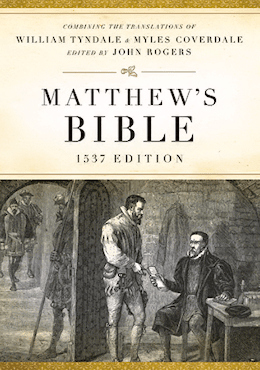Textus Receptus Bibles
Matthew's Bible 1537
| 12:1 | Then the Lorde sayed vnto Abram. Get the out of thy contrye and frome thy kyndred, and oute of thy fathers house, into a Lande whyche I wyll shewe the. |
| 12:2 | And I wyll make of the a myghty people, and wyll blesse the, and make thy name greate, that thou maiste be a blessynge. |
| 12:3 | And I wyl blesse them that blesse the and cursse them that cursse the. And in the shal be blessed al the generations of the earth. |
| 12:4 | And Abram went as the lord badde hym, and Lot wente wyth hym. Abram was .lxxv. yere olde when he went out of Haran. |
| 12:5 | And Abram toke Sarai hys wyfe, and Lot hys brothers son, wt al their goodes which they had gotten, and soules whiche they had begotten in Haran. And they departed in goo into the Lande of Canaan. |
| 12:6 | And when they were come into the Lande of Canaan, Abram went forthe into the Lande tyl he came vnto a place called Sichem, & vnto the oke of More. And the Kananytes dwelled then in the lande. |
| 12:7 | Then the Lorde appeared vnto Abram & sayd: vnto thy seed wyll I gyue this lande. And he builded an aulter ther vnto the Lord whyche appeared vnto hym. |
| 12:8 | Then departed he thence vnto a mountayne that lyeth on the east syde of Bethell & pitched hys tente: Bethel beynge on the west syde, and Ay on the east: and he builded there an aulter vnto the Lord, & called on the name of the Lorde. |
| 12:9 | And then Abram departed and toke hys iourney southwarde. |
| 12:10 | After thys ther came a derth in the lande. And Abram went downe into Egypte, to soiourne ther, for the derth was sore in the land. |
| 12:11 | And when he was come nye for to enter into Egypte, he sayed vnto Sarai hys wyfe. Behold, I knowe that thou art a fayre woman to loke vpon. |
| 12:12 | It wyll come to passe therfore when the Egyptyans se the, that they wyll saye: she is hys wyfe. And so shall they sley me and saue the. |
| 12:13 | Saye I pray the therfore that thou arte my sister that I maye fare the better by reason of the, and that my soule may lyue for thy sake. |
| 12:14 | As soone as he came into Egypte, the Egypsians saw the woman that she was very fayre. |
| 12:15 | And Pharaos Lodres sawe hir also, & praysed hyr vnto Pharao: So that she was taken into Pharaos house, |
| 12:16 | which entreated Abram wel for hir sake, so that he had shepe oxen, & he Asses, men seruauntes, mayd seruantes, she asses, and camels. |
| 12:17 | But God plaged Pharao, and his house wt greate plages, bycause of Sarai Abrams wyfe. |
| 12:18 | Then Pharao called Abram & sayed: Whi hast thou thus dealt wt me? Wherfore toldest thou me not that she was thy wyfe? |
| 12:19 | Why saydest thou, that she was thy sister, & causedeste me to take hyr to my wyfe? But nowe loo, there is thy wyfe, take hyr and be walkynge. |
| 12:20 | Pharao also gaue a charge vnto his menne ouer Abram, to leade hym oute, with hys wyfe, and all that he had. |

Matthew's Bible 1537
The Matthew Bible, also known as Matthew's Version, was first published in 1537 by John Rogers, under the pseudonym "Thomas Matthew". It combined the New Testament of William Tyndale, and as much of the Old Testament as he had been able to translate before being captured and put to death, with the translations of Myles Coverdale as to the balance of the Old Testament and the Apocrypha, except the Apocryphal Prayer of Manasses. It is thus a vital link in the main sequence of English Bible translations.